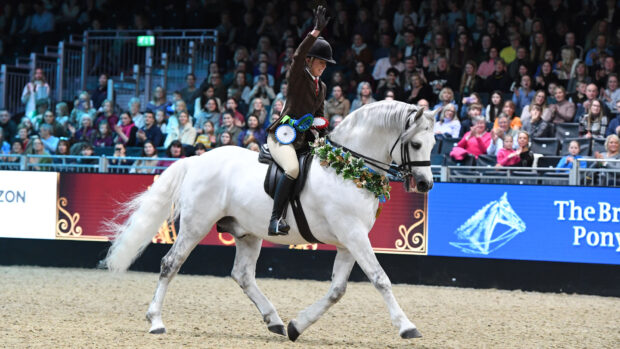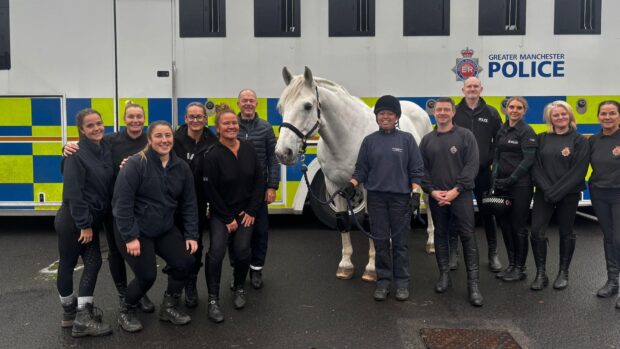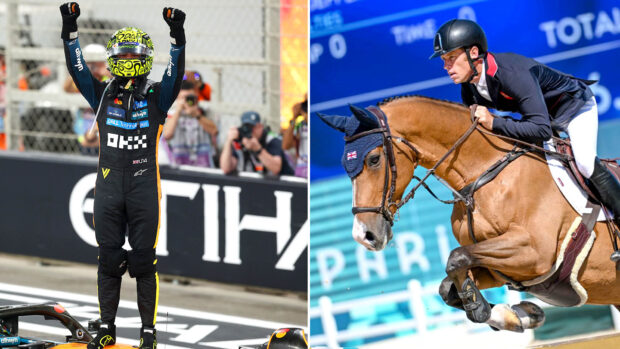To be an effective horse trainer and rider, we must endeavour to understand how horses learn, and to work within that framework. In the first part of this series on the theory of horses’ learning processes, we examined the first level – non-associative learning . After this comes classical conditioning and operant conditioning. In this article, we will look at classical conditioning for horses, the second level of learning.
What is classical conditioning for horses?
Most people are familiar with the story of Pavlov’s dogs. Pavlov was a Russian scientist who rang a bell and then fed the dogs in his experiment. It did not take long before the dogs would start to salivate and wag their tails when they heard the bell, even though no food was present.
Pavlov’s dogs: predicting what comes next due to a stimulus. The dogs learned to associate the bell with imminent provision of food. Credit: Alamy
Classical conditioning is all about predicting what will happen next because the order of events is always the same. Classical conditioning results in an emotional state being triggered by a previously neutral stimulus – once trained, Pavlov’s dogs became excited when they heard the bell because it predicted food.
Another key aspect to understand is that the neutral stimulus (in that case, the bell) has to be presented before the innate reinforcer (the food). If the bell was rung after the food, or even at the same time as food was presented, the effect would not be the same.
We can use classical conditioning as part of good training, but we should also be aware of where it causes us problems.
How can we use it?
{"content":"PHA+T25lIHdheSBpcyBhbHdheXMgdG8gZ2l2ZSBhIHBvc3R1cmFsIGN1ZSBpbW1lZGlhdGVseSBiZWZvcmUgYW4gYWlkIGZyb20gdGhlIGxlZyBvciBoYW5kLCBzdWNoIGFzIHNsb3dpbmcgeW91ciByaXNpbmcgaW4gdHJvdCBiZWZvcmUgYXNraW5nIGZvciBhIGRvd253YXJkcyB0cmFuc2l0aW9uLiBZb3Ugd2lsbCBiZSBzdXJwcmlzZWQgaG93IHF1aWNrbHkgeW91ciBob3JzZSBsZWFybnMgdG8gcmVzcG9uZCB0byB0aGUgcG9zdHVyYWwgY3VlIGFsb25lIOKAkyBnZXR0aW5nIHlvdSB0b3AgbWFya3MgZm9yIGhhcm1vbnkuPC9wPgo8cD5XZSBjYW4gYWxzbyB1c2UgdGhpcyBwaGVub21lbm9uIHRvIGludHJvZHVjZSBob3JzZXMgdG8gbm92ZWwgc3RpbXVsaS4gSWYgeW91IGhhdmUgYSB5b3VuZyBob3JzZSB5b3UgY2FuIHN0YW5kIHRoZW0gbmVhciB0byBvdGhlciBob3JzZXMgd2hvIGFyZSBiZWluZyBzaG9kIGFuZCBhc3NvY2lhdGUgdGhpcyB3aXRoIHNvbWV0aGluZyBuaWNlIGxpa2UgYSBtaW5lcmFsIGxpY2sgb3IgZ2V0dGluZyBzdHVjayBpbnRvIHRoZWlyIGZhdm91cml0ZSBzY3JhdGNoeSBzcG90cy48L3A+CjxwPjxiciAvPgo8ZGl2IGlkPSJhdHRhY2htZW50Xzg4NzM0MCIgc3R5bGU9IndpZHRoOiAxNDEwcHgiIGNsYXNzPSJ3cC1jYXB0aW9uIGFsaWdubm9uZSI+PGltZyBmZXRjaHByaW9yaXR5PSJoaWdoIiBkZWNvZGluZz0iYXN5bmMiIGFyaWEtZGVzY3JpYmVkYnk9ImNhcHRpb24tYXR0YWNobWVudC04ODczNDAiIGNsYXNzPSJsYXp5bG9hZCBibHVyLXVwIHdwLWltYWdlLTg4NzM0MCBzaXplLWZ1bGwiIGRhdGEtcHJvY2Vzc2VkIHNyYz0iaHR0cHM6Ly9rZXlhc3NldHMudGltZWluY3VrLm5ldC9pbnNwaXJld3AvbGl2ZS93cC1jb250ZW50L3VwbG9hZHMvc2l0ZXMvMTQvMjAxNy8wMy9uZXctaGgtcGxhY2Vob2xkZXItMjAweDIwMC5wbmciIGRhdGEtc3JjPSJodHRwczovL2tleWFzc2V0cy50aW1laW5jdWsubmV0L2luc3BpcmV3cC9saXZlL3dwLWNvbnRlbnQvdXBsb2Fkcy9zaXRlcy8xNC8yMDI1LzAzL0hBSDAwLmxiX3N0b2Nrc3ByaW5nMjMuRmVlZGluZ19fRjJBMjExMi5qcGciIGFsdD0iR2l2aW5nIGEgaG9yc2UgYSB0cmVhdCwgY2FuIGJlIHVzZWQgYXMgcGFydCBvZiBjbGFzc2ljYWwgY29uZGl0aW9uaW5nIGZvciBob3JzZXMiIHdpZHRoPSIxNDAwIiBoZWlnaHQ9Ijc4OCIgZGF0YS1zaXplcz0iYXV0byIgZGF0YS1zcmNzZXQ9Imh0dHBzOi8va2V5YXNzZXRzLnRpbWVpbmN1ay5uZXQvaW5zcGlyZXdwL2xpdmUvd3AtY29udGVudC91cGxvYWRzL3NpdGVzLzE0LzIwMjUvMDMvSEFIMDAubGJfc3RvY2tzcHJpbmcyMy5GZWVkaW5nX19GMkEyMTEyLmpwZyAxNDAwdywgaHR0cHM6Ly9rZXlhc3NldHMudGltZWluY3VrLm5ldC9pbnNwaXJld3AvbGl2ZS93cC1jb250ZW50L3VwbG9hZHMvc2l0ZXMvMTQvMjAyNS8wMy9IQUgwMC5sYl9zdG9ja3NwcmluZzIzLkZlZWRpbmdfX0YyQTIxMTItMzAweDE2OS5qcGcgMzAwdywgaHR0cHM6Ly9rZXlhc3NldHMudGltZWluY3VrLm5ldC9pbnNwaXJld3AvbGl2ZS93cC1jb250ZW50L3VwbG9hZHMvc2l0ZXMvMTQvMjAyNS8wMy9IQUgwMC5sYl9zdG9ja3NwcmluZzIzLkZlZWRpbmdfX0YyQTIxMTItNjMweDM1NS5qcGcgNjMwdywgaHR0cHM6Ly9rZXlhc3NldHMudGltZWluY3VrLm5ldC9pbnNwaXJld3AvbGl2ZS93cC1jb250ZW50L3VwbG9hZHMvc2l0ZXMvMTQvMjAyNS8wMy9IQUgwMC5sYl9zdG9ja3NwcmluZzIzLkZlZWRpbmdfX0YyQTIxMTItMTM1eDc2LmpwZyAxMzV3LCBodHRwczovL2tleWFzc2V0cy50aW1laW5jdWsubmV0L2luc3BpcmV3cC9saXZlL3dwLWNvbnRlbnQvdXBsb2Fkcy9zaXRlcy8xNC8yMDI1LzAzL0hBSDAwLmxiX3N0b2Nrc3ByaW5nMjMuRmVlZGluZ19fRjJBMjExMi0zMjB4MTgwLmpwZyAzMjB3LCBodHRwczovL2tleWFzc2V0cy50aW1laW5jdWsubmV0L2luc3BpcmV3cC9saXZlL3dwLWNvbnRlbnQvdXBsb2Fkcy9zaXRlcy8xNC8yMDI1LzAzL0hBSDAwLmxiX3N0b2Nrc3ByaW5nMjMuRmVlZGluZ19fRjJBMjExMi02MjB4MzQ5LmpwZyA2MjB3LCBodHRwczovL2tleWFzc2V0cy50aW1laW5jdWsubmV0L2luc3BpcmV3cC9saXZlL3dwLWNvbnRlbnQvdXBsb2Fkcy9zaXRlcy8xNC8yMDI1LzAzL0hBSDAwLmxiX3N0b2Nrc3ByaW5nMjMuRmVlZGluZ19fRjJBMjExMi05MjB4NTE4LmpwZyA5MjB3LCBodHRwczovL2tleWFzc2V0cy50aW1laW5jdWsubmV0L2luc3BpcmV3cC9saXZlL3dwLWNvbnRlbnQvdXBsb2Fkcy9zaXRlcy8xNC8yMDI1LzAzL0hBSDAwLmxiX3N0b2Nrc3ByaW5nMjMuRmVlZGluZ19fRjJBMjExMi0xMjIweDY4Ny5qcGcgMTIyMHciIHNpemVzPSIobWF4LXdpZHRoOiAxNDAwcHgpIDEwMHZ3LCAxNDAwcHgiIC8+PHAgaWQ9ImNhcHRpb24tYXR0YWNobWVudC04ODczNDAiIGNsYXNzPSJ3cC1jYXB0aW9uLXRleHQiPkdpdmluZyB5b3VyIGhvcnNlIHNvbWV0aGluZyBuaWNlIHRvIGxpY2ssIG9yIGEgZ29vZCBzY3JhdGNoLCBjYW4gYnVpbGQgcG9zaXRpdmUgYXNzb2NpYXRpb25zIHdpdGggc29tZXRoaW5nIG5ldyBvciB0aGF0IHRoZXkgbWF5IGZpbmQgc2NhcnkuIENyZWRpdDogQW5kcmV3IFN5ZGVuaGFtPC9wPjwvZGl2PjwvcD4KPHA+WW91IGhhdmUgdG8gc3RhbmQgZmFyIGVub3VnaCBhd2F5IHRoYXQgdGhleSBjYW4gcmVtYWluIGNhbG0gYW5kIGVuam95IHRoZSBleHBlcmllbmNlLCBidXQgaWYgeW91IGFsd2F5cyBwcmVzZW50IHNvbWV0aGluZyBuaWNlIHdoZW4gZmFycmllcnMgc3RhcnQgd29ya2luZyB0aGVuIHRoZSBhcnJpdmFsIG9mIGEgZmFycmllciB3aWxsIGhhdmUgdGhlIHNhbWUgZWZmZWN0IGFzIFBhdmxvduKAmXMgYmVsbCDigJMgYW5kIHlvdSB3aWxsIGhhdmUgYSBoYXBweSwgcmVsYXhlZCBob3JzZSB3aG8gd2lsbCBsZXNzIGxpa2VseSB0byBiZSBjb25jZXJuZWQgYWJvdXQgdGhlaXIgZmlyc3Qgc2V0IG9mIHNob2VzLjwvcD4KCjxoMz5XaGVuIGRvZXMgaXQgY2F1c2UgdXMgcHJvYmxlbXM\/PC9oMz4KPHA+UGVyaGFwcyB5b3UgaGF2ZSBhIGhvcnNlIHdobyBsYWNrcyBjb25maWRlbmNlIHRvIGp1bXAgYSBmaWxsZXIuIElmIHRoZSBob3JzZSBpcyBwdXQgdW5kZXIgcHJlc3N1cmUgZXZlcnkgdGltZSB0aGV5IGFwcHJvYWNoIGEgZmlsbGVyIChieSBsZWcsIHZvaWNlIG9yIHdoaXApIHRoZXkgd2lsbCBzdGFydCB0byBhc3NvY2lhdGUgdGhlIHNpZ2h0IG9mIGEgZmlsbGVyIHdpdGggaW5jcmVhc2VkIHByZXNzdXJlIGZyb20gdGhlIHJpZGVyLjwvcD4KPHA+QXMgYSBodW1hbiB3ZSBoYXZlIHRoZSBjb2duaXRpdmUgY2FwYWNpdHkgdG8gdW5kZXJzdGFuZCB0aGF0IGlmIHRoZXkganVtcCBpdCB0aGV5IHdvbuKAmXQgYmUgcHV0IHVuZGVyIHByZXNzdXJlLiBCdXQgaG9yc2VzIGNhbuKAmXQgcmF0aW9uYWxpc2UgdGhvdWdodHMgbGlrZSB0aGVzZS4gU28gaW5zdGVhZCwgdGhleSBzZWUgdGhlIGZpbGxlciwgd2hpY2ggdHJpZ2dlcnMgbmVnYXRpdmUgZW1vdGlvbnMgbGlrZSBmZWFyIGFuZCBhbnhpZXR5IGFuZCBzbyB0aGV5LCB1bmRlcnN0YW5kYWJseSwgd2FudCB0byBhdm9pZCBpdC48L3A+CjxwPjxiciAvPgo8ZGl2IGlkPSJhdHRhY2htZW50Xzg4NzQyNCIgc3R5bGU9IndpZHRoOiAxNDEwcHgiIGNsYXNzPSJ3cC1jYXB0aW9uIGFsaWdubm9uZSI+PGltZyBkZWNvZGluZz0iYXN5bmMiIGFyaWEtZGVzY3JpYmVkYnk9ImNhcHRpb24tYXR0YWNobWVudC04ODc0MjQiIGNsYXNzPSJsYXp5bG9hZCBibHVyLXVwIHNpemUtZnVsbCB3cC1pbWFnZS04ODc0MjQiIGRhdGEtcHJvY2Vzc2VkIHNyYz0iaHR0cHM6Ly9rZXlhc3NldHMudGltZWluY3VrLm5ldC9pbnNwaXJld3AvbGl2ZS93cC1jb250ZW50L3VwbG9hZHMvc2l0ZXMvMTQvMjAxNy8wMy9uZXctaGgtcGxhY2Vob2xkZXItMjAweDIwMC5wbmciIGRhdGEtc3JjPSJodHRwczovL2tleWFzc2V0cy50aW1laW5jdWsubmV0L2luc3BpcmV3cC9saXZlL3dwLWNvbnRlbnQvdXBsb2Fkcy9zaXRlcy8xNC8yMDI1LzAzLzJYMDhOSFIuanBnIiBhbHQ9IkdyZXkgaG9yc2UgcmVmdXNpbmcgZmVuY2UuICIgd2lkdGg9IjE0MDAiIGhlaWdodD0iNzg4IiBkYXRhLXNpemVzPSJhdXRvIiBkYXRhLXNyY3NldD0iaHR0cHM6Ly9rZXlhc3NldHMudGltZWluY3VrLm5ldC9pbnNwaXJld3AvbGl2ZS93cC1jb250ZW50L3VwbG9hZHMvc2l0ZXMvMTQvMjAyNS8wMy8yWDA4TkhSLmpwZyAxNDAwdywgaHR0cHM6Ly9rZXlhc3NldHMudGltZWluY3VrLm5ldC9pbnNwaXJld3AvbGl2ZS93cC1jb250ZW50L3VwbG9hZHMvc2l0ZXMvMTQvMjAyNS8wMy8yWDA4TkhSLTMwMHgxNjkuanBnIDMwMHcsIGh0dHBzOi8va2V5YXNzZXRzLnRpbWVpbmN1ay5uZXQvaW5zcGlyZXdwL2xpdmUvd3AtY29udGVudC91cGxvYWRzL3NpdGVzLzE0LzIwMjUvMDMvMlgwOE5IUi02MzB4MzU1LmpwZyA2MzB3LCBodHRwczovL2tleWFzc2V0cy50aW1laW5jdWsubmV0L2luc3BpcmV3cC9saXZlL3dwLWNvbnRlbnQvdXBsb2Fkcy9zaXRlcy8xNC8yMDI1LzAzLzJYMDhOSFItMTM1eDc2LmpwZyAxMzV3LCBodHRwczovL2tleWFzc2V0cy50aW1laW5jdWsubmV0L2luc3BpcmV3cC9saXZlL3dwLWNvbnRlbnQvdXBsb2Fkcy9zaXRlcy8xNC8yMDI1LzAzLzJYMDhOSFItMzIweDE4MC5qcGcgMzIwdywgaHR0cHM6Ly9rZXlhc3NldHMudGltZWluY3VrLm5ldC9pbnNwaXJld3AvbGl2ZS93cC1jb250ZW50L3VwbG9hZHMvc2l0ZXMvMTQvMjAyNS8wMy8yWDA4TkhSLTYyMHgzNDkuanBnIDYyMHcsIGh0dHBzOi8va2V5YXNzZXRzLnRpbWVpbmN1ay5uZXQvaW5zcGlyZXdwL2xpdmUvd3AtY29udGVudC91cGxvYWRzL3NpdGVzLzE0LzIwMjUvMDMvMlgwOE5IUi05MjB4NTE4LmpwZyA5MjB3LCBodHRwczovL2tleWFzc2V0cy50aW1laW5jdWsubmV0L2luc3BpcmV3cC9saXZlL3dwLWNvbnRlbnQvdXBsb2Fkcy9zaXRlcy8xNC8yMDI1LzAzLzJYMDhOSFItMTIyMHg2ODcuanBnIDEyMjB3IiBzaXplcz0iKG1heC13aWR0aDogMTQwMHB4KSAxMDB2dywgMTQwMHB4IiAvPjxwIGlkPSJjYXB0aW9uLWF0dGFjaG1lbnQtODg3NDI0IiBjbGFzcz0id3AtY2FwdGlvbi10ZXh0Ij5BIGhvcnNlIG1heSBhc3NvY2lhdGUgdGhlIHNpZ2h0IG9mIGEgc3Bvb2t5IGp1bXAgd2l0aCBhbiBpbmNyZWFzZSBpbiBwcmVzc3VyZSBmcm9tIHRoZSByaWRlciwgYnV0IHdpdGggdGltZSBhbmQgcGF0aWVuY2UsIHlvdSBjYW4gYnVpbGQgdGhlaXIgY29uZmlkZW5jZSBzbyB0aGV5IG5vIGxvbmdlciBhbnRpY2lwYXRlIHRoZSBwZXJjZWl2ZWQgdGhyZWF0LiBDcmVkaXQ6IEFsYW15PC9wPjwvZGl2PjwvcD4KPHA+SW5zdGVhZCwgaXQgaXMgYmV0dGVyIHRvIGhlbHAgdGhlIGhvcnNlIGZvcm0gcG9zaXRpdmUgYXNzb2NpYXRpb25zIHdpdGggZmlsbGVycyBzbyB0aGV5IGJlY29tZSBtb3JlIGNvbmZpZGVudC4gVGhpcyBtaWdodCBzdGFydCB3aXRoIHdhbGtpbmcgdG93YXJkcyBvbmUsIHN0b3BwaW5nIGJlZm9yZSB0aGV5IGdldCB0b28gY2xvc2UgYW5kIGJlY29tZSBmZWFyZnVsLCBsZXR0aW5nIHRoZW0gc3RhbmQgYW5kIHRoZW4gZ2l2aW5nIHRoZW0gYSBzY3JhdGNoLCB0aGVuIHJlcGVhdGluZyB0aGlzIHNldmVyYWwgdGltZXMuIE5vdyBhcHByb2FjaGluZyB0aGUgZmlsbGVyIHByZWRpY3RzIGEgcmVkdWN0aW9uIGluIHByZXNzdXJlIGFuZCB0aGUgcG9zc2liaWxpdHkgZm9yIGEgcG9zaXRpdmUgZXhwZXJpZW5jZSAodGhlIHNjcmF0Y2gpLjwvcD4KPHA+T25jZSB0aGV5IGFyZSBjb25maWRlbnQgdHJ5IHdhbGtpbmcgdGhlbiB0cm90dGluZyBiZXR3ZWVuIHR3byBmaWxsZXJzIHdpdGggYSB3aWRlIGdhcCB0aGF0IHlvdSBncmFkdWFsbHkgbWFrZSBzbWFsbGVyIOKAkyByZW1lbWJlciB0byBrZWVwIGl0IGVhc3ksIHRoZSBhaW0gaXMgdGhhdCB0aGUgc2lnaHQgb2YgdGhlIGZpbGxlciBlbGljaXRzIHBvc2l0aXZlIGVtb3Rpb25zIGFuZCBub3QgbmVnYXRpdmUgb25lcy48L3A+CjxwPllvdSBjb3VsZCBldmVuIGp1bXAgb3ZlciBzZXZlcmFsIG90aGVyIGZlbmNlcyBiZWZvcmUgdHJvdHRpbmcgYmV0d2VlbiB0aGUgZmlsbGVycyBhbmQgdGhlbiBicmluZyB0aGUgaG9yc2UgYmFjayB0byB3YWxrIG9uIGEgbG9uZyByZWluIGZvciBhIG1pbnV0ZSBvbiB0aGUgb3RoZXIgc2lkZS4gQXBwcm9hY2hpbmcgdGhlIGZpbGxlciBub3cgcHJlZGljdHMgYSBicmVhayBpbiB0cmFpbmluZyBhbmQgdGhlIGhvcnNlIHdpbGwgYmUgYWN0aXZlbHkgd2FudGluZyB0byB0YWtlIHlvdSB0byBpdC4gQXQgdGhpcyBwb2ludCB0aGUgZ2FwIGlzIHByb2JhYmx5IHRoYXQgc21hbGwgdGhhdCB0aGV5IGFyZSBqdW1waW5nIHRoZSBmaWxsZXIuPC9wPgo8cD5UbyBjb3VudGVyYWN0IHRoZSByaXNrIHRoYXQgdGhlIGhvcnNlIHdpbGwgbGVhcm4gdG8gc3RvcCBhZnRlciBhIGZpbGxlciwgb25jZSB5b3UgaGF2ZSB0aGVtIGNvbmZpZGVudCB0byBqdW1wIGl0IGFuZCB0aGV5IGFyZSBkcmF3aW5nIHlvdSB0byBpdCwgcG9wIHRoZSBmaWxsZXIgYW5kIHRoZW4gYXNrIGZvciBhIGNpcmNsZSBpbiBjYW50ZXIgYmVmb3JlIGNvbWluZyBiYWNrIHRvIHdhbGsuIEJ1aWxkIHVwIHRvIHdoZXJlIHRoZXkganVtcCBpdCBhbmQgbG9vayBmb3IgdGhlIG5leHQgcXVlc3Rpb24uPC9wPgo8cD5JZiB5b3UgaGF2ZSB0cmFpbmVkIHRoaXMgd2VsbCBpdCB3aWxsIGJlY29tZSB0aGVpciBmYXZvdXJpdGUganVtcCE8L3A+CjxoMz5DYXNlIHN0dWR5IGZvciBjbGFzc2ljYWwgY29uZGl0aW9uaW5nOiBvdmVyY29taW5nIGNsaXBwZXIgZmVhcjwvaDM+CjxwPkEgdGVlbmFnZSBjb2IgbWFyZSB3YXMgdGhlIHBlcmZlY3QgaG9yc2UgZm9yIGhlciBvd25lciwgYXBhcnQgZnJvbSBoZXIgYXZlcnNpb24gdG8gY2xpcHBlcnMuIEV2ZW4gd2hlbiBzZWRhdGVkIHNoZSBiZWNhbWUgZGFuZ2Vyb3VzIHRvIGNsaXAuIEluIHRoaXMgc2NlbmFyaW8gdGhlIGNsaXBwZXJzIGVsaWNpdGVkIGEgZmVhciByZXNwb25zZSB0aGF0IG92ZXJyb2RlIHRoZSBzZWRhdGlvbi48L3A+CjxwPldlIHN0YXJ0ZWQgYnkgdHVybmluZyBvbiBzb21lIGh1bWFuIGJlYXJkIGNsaXBwZXJzLCBnaXZpbmcgaGVyIGEgaGFuZGZ1bCBvZiBjaGFmZiBhbmQgdHVybmluZyB0aGVtIG9mZiBhZ2Fpbi4gVGhlIG5vaXNlIHdhcyBiZWxvdyB0aGUgdGhyZXNob2xkIHRoYXQgZWxpY2l0ZWQgYSBmZWFyIHJlc3BvbnNlIGFuZCB0aGUgc291bmQgc29vbiBiZWdhbiB0byBwcmVkaWN0IGZvb2QuIEdyYWR1YWxseSB0aGUgYmVhcmQgY2xpcHBlcnMgd2VyZSBicm91Z2h0IGNsb3NlciBhbmQgdGhlbiBydWJiZWQgb24gaGVyIGJvZHksIHR1cm5pbmcgdGhlbSBvbiB3YXMgc3RpbGwgYWx3YXlzIGZvbGxvd2VkIGJ5IGZvb2QuPC9wPgo8cD5UaGUgc2FtZSBwcm9jZXNzIHdhcyByZXBlYXRlZCB3aXRoIHNtYWxsIGFuZCBldmVudHVhbGx5IGxhcmdlIGNsaXBwZXJzLiBBbnlvbmUgd2F0Y2hpbmcgd291bGQgaGF2ZSBmb3VuZCB0aGUgcHJvY2VzcyBib3JpbmcgYXMgc2hlIHJlbWFpbmVkIGNhbG0gdGhyb3VnaG91dCDigJMgYSBzaWduIG9mIGdvb2QgdHJhaW5pbmcuIE5vdyBzaGUgc3RhbmRzIHdpdGggbm8gc2VkYXRpb24gdG8gYmUgY2xpcHBlZCBhbGwgb3Zlci48L3A+CjxkaXYgY2xhc3M9ImluamVjdGlvbiI+PC9kaXY+CjxkaXYgaWQ9ImF0dGFjaG1lbnRfODg3MzM1IiBzdHlsZT0id2lkdGg6IDE0MTBweCIgY2xhc3M9IndwLWNhcHRpb24gYWxpZ25ub25lIj48aW1nIGRlY29kaW5nPSJhc3luYyIgYXJpYS1kZXNjcmliZWRieT0iY2FwdGlvbi1hdHRhY2htZW50LTg4NzMzNSIgY2xhc3M9Imxhenlsb2FkIGJsdXItdXAgd3AtaW1hZ2UtODg3MzM1IHNpemUtZnVsbCIgZGF0YS1wcm9jZXNzZWQgc3JjPSJodHRwczovL2tleWFzc2V0cy50aW1laW5jdWsubmV0L2luc3BpcmV3cC9saXZlL3dwLWNvbnRlbnQvdXBsb2Fkcy9zaXRlcy8xNC8yMDE3LzAzL25ldy1oaC1wbGFjZWhvbGRlci0yMDB4MjAwLnBuZyIgZGF0YS1zcmM9Imh0dHBzOi8va2V5YXNzZXRzLnRpbWVpbmN1ay5uZXQvaW5zcGlyZXdwL2xpdmUvd3AtY29udGVudC91cGxvYWRzL3NpdGVzLzE0LzIwMjUvMDMvR2V0dHlJbWFnZXMtNTgyNjcxMzA4LmpwZyIgYWx0PSJIb3JzZSBiZWluZyBjbGlwcGVkOiBhIHBhdGllbnQgYXBwcm9hY2ggd2l0aCByZXdhcmRzIGlzIGFuIGV4YW1wbGUgb2YgY2xhc3NpY2FsIGNvbmRpdGlvbmluZyBmb3IgaG9yc2VzIiB3aWR0aD0iMTQwMCIgaGVpZ2h0PSI3ODgiIGRhdGEtc2l6ZXM9ImF1dG8iIGRhdGEtc3Jjc2V0PSJodHRwczovL2tleWFzc2V0cy50aW1laW5jdWsubmV0L2luc3BpcmV3cC9saXZlL3dwLWNvbnRlbnQvdXBsb2Fkcy9zaXRlcy8xNC8yMDI1LzAzL0dldHR5SW1hZ2VzLTU4MjY3MTMwOC5qcGcgMTQwMHcsIGh0dHBzOi8va2V5YXNzZXRzLnRpbWVpbmN1ay5uZXQvaW5zcGlyZXdwL2xpdmUvd3AtY29udGVudC91cGxvYWRzL3NpdGVzLzE0LzIwMjUvMDMvR2V0dHlJbWFnZXMtNTgyNjcxMzA4LTMwMHgxNjkuanBnIDMwMHcsIGh0dHBzOi8va2V5YXNzZXRzLnRpbWVpbmN1ay5uZXQvaW5zcGlyZXdwL2xpdmUvd3AtY29udGVudC91cGxvYWRzL3NpdGVzLzE0LzIwMjUvMDMvR2V0dHlJbWFnZXMtNTgyNjcxMzA4LTYzMHgzNTUuanBnIDYzMHcsIGh0dHBzOi8va2V5YXNzZXRzLnRpbWVpbmN1ay5uZXQvaW5zcGlyZXdwL2xpdmUvd3AtY29udGVudC91cGxvYWRzL3NpdGVzLzE0LzIwMjUvMDMvR2V0dHlJbWFnZXMtNTgyNjcxMzA4LTEzNXg3Ni5qcGcgMTM1dywgaHR0cHM6Ly9rZXlhc3NldHMudGltZWluY3VrLm5ldC9pbnNwaXJld3AvbGl2ZS93cC1jb250ZW50L3VwbG9hZHMvc2l0ZXMvMTQvMjAyNS8wMy9HZXR0eUltYWdlcy01ODI2NzEzMDgtMzIweDE4MC5qcGcgMzIwdywgaHR0cHM6Ly9rZXlhc3NldHMudGltZWluY3VrLm5ldC9pbnNwaXJld3AvbGl2ZS93cC1jb250ZW50L3VwbG9hZHMvc2l0ZXMvMTQvMjAyNS8wMy9HZXR0eUltYWdlcy01ODI2NzEzMDgtNjIweDM0OS5qcGcgNjIwdywgaHR0cHM6Ly9rZXlhc3NldHMudGltZWluY3VrLm5ldC9pbnNwaXJld3AvbGl2ZS93cC1jb250ZW50L3VwbG9hZHMvc2l0ZXMvMTQvMjAyNS8wMy9HZXR0eUltYWdlcy01ODI2NzEzMDgtOTIweDUxOC5qcGcgOTIwdywgaHR0cHM6Ly9rZXlhc3NldHMudGltZWluY3VrLm5ldC9pbnNwaXJld3AvbGl2ZS93cC1jb250ZW50L3VwbG9hZHMvc2l0ZXMvMTQvMjAyNS8wMy9HZXR0eUltYWdlcy01ODI2NzEzMDgtMTIyMHg2ODcuanBnIDEyMjB3IiBzaXplcz0iKG1heC13aWR0aDogMTQwMHB4KSAxMDB2dywgMTQwMHB4IiAvPjxwIGlkPSJjYXB0aW9uLWF0dGFjaG1lbnQtODg3MzM1IiBjbGFzcz0id3AtY2FwdGlvbi10ZXh0Ij5BbiBhdmVyc2lvbiB0byBjbGlwcGluZyBjYW4gYmUgd29ya2VkIHRocm91Z2ggc2xvd2x5IGFuZCBwYXRpZW50bHksIHVzaW5nIGNsYXNzaWNhbCBjb25kaXRpb25pbmcgdG8gdGVhY2ggdGhlIGhvcnNlIHRoYXQgdGhlIG5vaXNlIG9mIHRoZSBjbGlwcGVycyBpbmRpY2F0ZXMgYW4gaW1taW5lbnQgcmV3YXJkLiBDcmVkaXQ6IEdldHR5L0tpdCBIb3VnaHRvbjwvcD48L2Rpdj4KPHA+V2XigJl2ZSBub3cgY292ZXJlZCBub24tYXNzb2NpYXRpdmUgbGVhcm5pbmcgYW5kIGNsYXNzaWNhbCBjb25kaXRpb25pbmcgYXMgdHdvIGltcG9ydGFudCBsZXZlbHMgaW4gdGhlIHRoZW9yeSBvZiBob3cgaG9yc2VzIGxlYXJuLiBUaGUgbmV4dCBhbmQgZmluYWwgcGFydCBvZiB0aGlzIHNlcmllcyB3aWxsIGFkZHJlc3Mgb3BlcmFudCBjb25kaXRpb25pbmcg4oCTIG9yLCBpbiBsYXltYW7igJlzIHRlcm0sIHJld2FyZHMgYW5kIGNvbnNlcXVlbmNlcy48L3A+CjxwPgo="}
You may also enjoy reading…
We all know that feeling when our horse suddenly spies something that we know is safe but they think is terrifying. Credit: Alamy
Credit: Alamy Stock Photo
Lottie Fry thanks Glamourdale with a stroke on the neck after his grand prix special performance at Paris 2024.
Credit: Peter Nixon
Cathrine Laurdup-Dufour and Vamos Amigos, pictured in the grand prix special at the 2022 World Dressage Championships.
Credit: Peter Nixon
Confidence and experience are essential for handling horses when they are fresh or spooky.
Credit: Philip Barker
Stay in touch with all the news in the run-up to and throughout the major shows and events during 2025 and beyond with a Horse & Hound subscription. Subscribe today for all you need to know ahead of these major events, plus online reports on the action as it happens from our expert team of reporters and in-depth analysis in our special commemorative magazines. Have a subscription already? Set up your unlimited website access now









